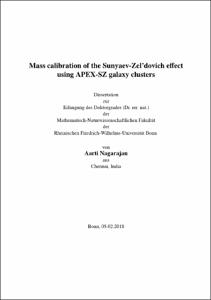Mass calibration of the Sunyaev-Zel'dovich effect using APEX-SZ galaxy clusters

Mass calibration of the Sunyaev-Zel'dovich effect using APEX-SZ galaxy clusters

| dc.contributor.advisor | Bertoldi, Frank | |
| dc.contributor.author | Nagarajan, Aarti | |
| dc.date.accessioned | 2020-04-25T14:13:30Z | |
| dc.date.available | 2020-04-25T14:13:30Z | |
| dc.date.issued | 14.12.2018 | |
| dc.identifier.uri | https://hdl.handle.net/20.500.11811/7687 | |
| dc.description.abstract | Clusters of galaxies are the most massive, gravitationally bound structures in the Universe. Their abundance across cosmic time and space is sensitive to cosmological parameters. Of particular interest to modern cosmology is the nature of the mysterious "dark energy" and the total mass of all neutrino species. To place tight constraints on these from cluster observations, it is crucial to accurately relate the cluster observables to the cluster masses, which are the link to theoretical modelling in cosmology. This work aims at measuring accurately the relationships between cluster properties and mass using a well-defined cluster sample. A conspicuous observable component of a cluster is the diffuse hot ( 10 7 K) ionized medium filling up the space between the galaxies. This intra-cluster medium emits X-rays and causes a well-understood distortion in the cosmic microwave background radiation spectrum known as the Sunyaev-Zel'dovich (SZ) effect. In this work, I calibrate the cluster SZ effect against the cluster total gravitational mass, making use of spatially resolved SZ observations of 39 galaxy clusters, obtained with the APEX telescope. These observations are riddled with atmospheric noise, which requires strong filtering to retrieve the cluster SZ signal that thereby is also attenuated and spatially distorted. In the first part of the thesis, I discuss various ways of estimating the true SZ signal from the filtered APEX observations, in order to obtain robust estimates of the SZ signal for all the clusters in the sample. In the second part, I focus on the SZ effect to mass scaling relation. I compare the SZ measurements with direct mass estimates obtained from gravitational lensing, a process by which the images of background galaxies are distorted by the gravitational potential of a cluster that deflects the light from its original path. For a reliable cosmological use of clusters, their mass-observable scalings must be obtained from a sample that is representative of the actual cluster population or whose composition and completeness (as a fraction of the underlying cluster population) are at least well-understood, such that resulting biases can be corrected for. For this reason, I restrict the analysis to a sub-sample of the APEX clusters, selected from an X-ray all-sky survey, and qualified as complete (>90%) inside a well-defined range of X-ray luminosities. I implement a novel Bayesian method to account for the sample selection biases, the measurement uncertainties, the shape of the cluster mass function and scatters in the true mass-observable relations. In particular, I allow for a possible covariance between the X-ray luminosity and the SZ effect at fixed mass, which so far has been neglected in similar works. The resulting calibration of the SZ to mass scaling relation shows sensitivity to this covariance. Neglecting the covariance causes the normalization of the SZ to mass relation to be biased high by one to two standard deviations, and the slope low by one standard deviation, even when the SZ effect plays no role in the sample selection. Based on different mass-observable scaling relations, I estimate the impact of such a systematic effect on forthcoming cosmological analyses by predicting the number of cluster detections in a near-future SZ survey experiment. The prediction from the trusted calibration yields 5000, whereas the scaling relation that ignores the X-ray luminosity and SZ covariance at fixed mass predicts the cluster count too high by a factor of four. This highlights the need for considering the intrinsic covariance of cluster properties in measuring scaling relations. For the higher-precision data and larger cluster samples anticipated from on-going and near-future cluster cosmology experiments, biases in the mass-observable calibrations from covariances of cluster properties could dominate the cosmological error budget if not considered with care. | |
| dc.language.iso | eng | |
| dc.rights | In Copyright | |
| dc.rights.uri | http://rightsstatements.org/vocab/InC/1.0/ | |
| dc.subject.ddc | 520 Astronomie, Kartografie | |
| dc.title | Mass calibration of the Sunyaev-Zel'dovich effect using APEX-SZ galaxy clusters | |
| dc.type | Dissertation oder Habilitation | |
| dc.publisher.name | Universitäts- und Landesbibliothek Bonn | |
| dc.publisher.location | Bonn | |
| dc.rights.accessRights | openAccess | |
| dc.identifier.urn | https://nbn-resolving.org/urn:nbn:de:hbz:5n-52975 | |
| ulbbn.pubtype | Erstveröffentlichung | |
| ulbbnediss.affiliation.name | Rheinische Friedrich-Wilhelms-Universität Bonn | |
| ulbbnediss.affiliation.location | Bonn | |
| ulbbnediss.thesis.level | Dissertation | |
| ulbbnediss.dissID | 5297 | |
| ulbbnediss.date.accepted | 28.06.2018 | |
| ulbbnediss.institute | Mathematisch-Naturwissenschaftliche Fakultät : Fachgruppe Physik/Astronomie / Argelander-Institut für Astronomie (AIfA) | |
| ulbbnediss.fakultaet | Mathematisch-Naturwissenschaftliche Fakultät | |
| dc.contributor.coReferee | Reiprich, Thomas H. |
Dateien zu dieser Ressource
Das Dokument erscheint in:
-
E-Dissertationen (4070)




